A dangerous trend is occurring on American roadways, one that’s putting those on foot directly in harm’s way: Pedestrian deaths are increasing at an unprecedented rate. And it’s nothing new – these tragedies have been on the uptick for years.
While so much focus remains on making drivers safer, why – and how – are we failing pedestrians?
Recent Pedestrian Deaths
An estimated 7,508 pedestrians died in traffic crashes in 2022 in the United States, according to the Governors Highway Safety Association.
The GHSA suggests the uptick in pedestrian deaths is likely the result of unsafe driving habits, such as excessive speeding, drunk and drugged driving and general distraction. The organization also points the finger at infrastructure it says is more conducive and safer for drivers instead of pedestrians.
Pedestrian Fatalities in the Northeast
Closer to home, projected pedestrian death totals in the Northeast were a mixed bag. The breakdown by state with the percentage of change from 2021 to 2022 includes:
Connecticut: 62 deaths, +10.7% increase
Massachusetts: 100; +31.6% increase
Maine: 21; +5.0%
New Hampshire: 16; +77.8%
New Jersey: 190; -12.4%
New York: 298; -2.0%
Rhode Island: 7; +/-0%
Vermont: 7; -12.5%
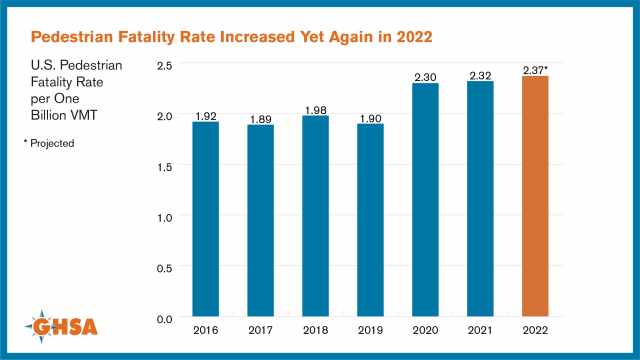
Pedestrian Deaths Per Year
2022’s pedestrian death totals are the latest results in a disturbing ongoing trend. From 2010-2021, U.S. pedestrian fatalities increased from 4,302 to an estimated 7,624, a whopping 77% jump. Over the same time period, all other traffic-related deaths grew by 25%, while total traffic fatalities increased by 31%.
A closer look at pedestrian deaths per year:
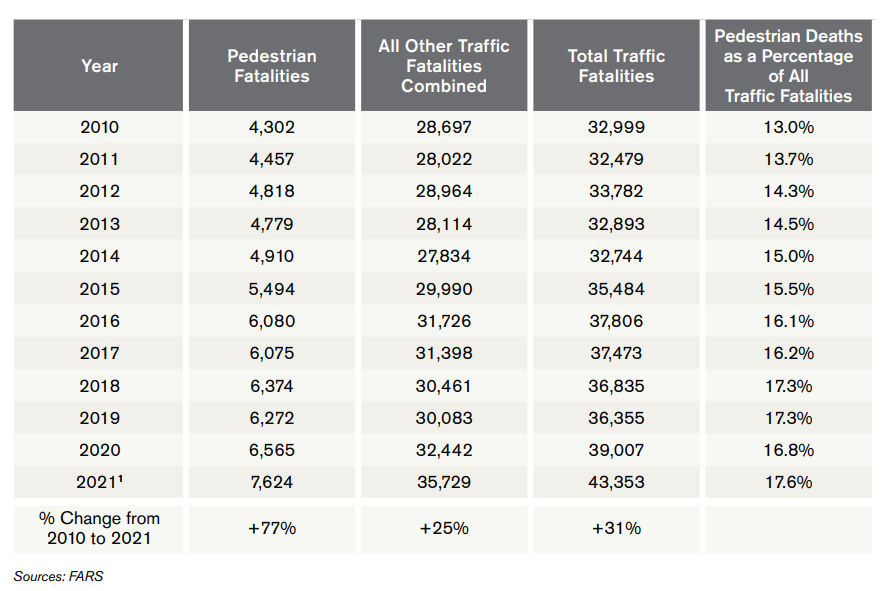
Why Are Pedestrian Deaths On the Rise?
There are a number of likely culprits responsible for the rise in pedestrian deaths, but experts most often point to one more than any other: the increase in SUVs on the road. The numbers support this theory. Although passenger cars remain most likely to be involved in fatal pedestrian crashes, the number of deaths involving SUVs grew 120% from 2012-2021, compared to 26% for cars. (Their popularity continues to rise, with light trucks including SUVs making up 78% of total light vehicle sales in 2021.)
The issue with SUVs is twofold. The large body and elevated carriage of SUVs create more significant blind spots for motorists, making it easier for pedestrians – particularly children – to go unseen. An Indiana news station demonstrated this in an experiment that proved seven children could fit in a line stretching out from the front bumper of an SUV without the driver seeing any of them.
The vehicle’s design is also responsible for the increased likelihood a pedestrian will die after being struck by one. The higher bumpers and front ends of larger vehicles means pedestrian victims often get struck in the torso or head, damaging vital organs. Sedans, on the other hand, most commonly strike pedestrians in their lower extremities. Furthermore, when a victim gets hit by a car, they are more likely to be pushed onto the hood or roof of the car, or off to the side. A pedestrian hit by a SUV will usually be knocked forward and possibly run over.
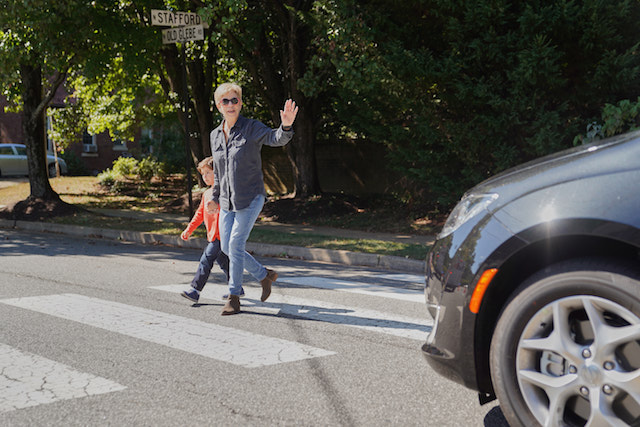
How to Stay Safe
Safety is always the top priority on the road, and following basic safety procedures will go a long way. These tips from the National Highway Traffic Safety Administration will help keep both pedestrians and motorists safe.
Pedestrians
- Be predictable. Follow the rules of the road and obey signs and signals.
- Walk on sidewalks whenever available.
- If there is no sidewalk, walk facing traffic and as far from traffic as possible.
- Keep alert at all times; don’t be distracted by electronic devices that take your eyes (and ears) off the road.
- Whenever possible, cross streets at crosswalks or intersections, where drivers expect pedestrians. Look for cars in all directions, including those turning left or right.
- If a crosswalk or intersection is not available, locate a well-lit area where you have the best view of traffic. Wait for a gap in traffic that allows enough time to cross safely; continue watching for traffic as you cross.
- Never assume a driver sees you. Make eye contact with drivers as they approach to make sure you are seen.
- Be visible at all times. Wear bright clothing during the day, and wear reflective materials or use a flashlight at night.
- Watch for cars entering or exiting driveways, or backing up in parking lots.
- Avoid alcohol and drugs when walking; they impair your abilities and your judgment.
Motorists
- Look out for pedestrians everywhere, at all times. Safety is a shared responsibility.
- Use extra caution when driving in hard-to-see conditions, such as nighttime or bad weather.
- Slow down and be prepared to stop when turning or otherwise entering a crosswalk.
- Yield to pedestrians in crosswalks and stop well back from the crosswalk to give other vehicles an opportunity to see the crossing pedestrians so they can stop too.
- Never pass vehicles stopped at a crosswalk. There may be people crossing that you can’t see.
- Never drive under the influence of alcohol and/or drugs.
- Follow the speed limit, especially around people on the street.
- Follow slower speed limits in school zones and in neighborhoods where children are present.
- Be extra cautious when backing up – pedestrians can move into your path.
For more safety advice, and to learn about free community programs, visit AAA.com.
57 Thoughts on “Why Are Pedestrian Deaths on the Rise?”
Leave A Comment
Comments are subject to moderation and may or may not be published at the editor’s discretion. Only comments that are relevant to the article and add value to the Your AAA community will be considered. Comments may be edited for clarity and length.



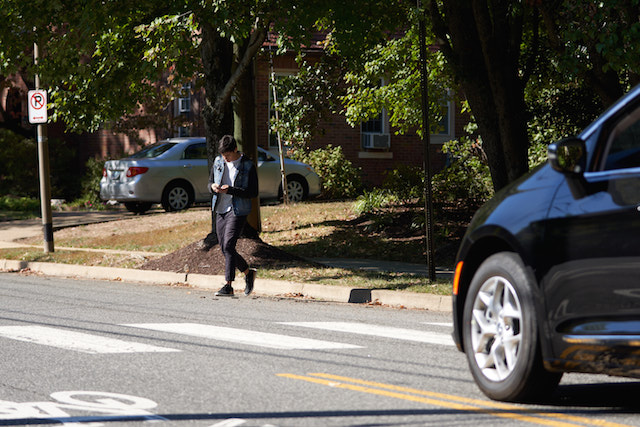



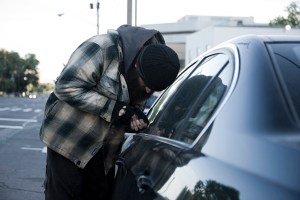








I think a lot of it has to do with people being taught pedestrians have the right of way, without also being taught they should stop and wait for traffic to clear before stepping into the crosswalk. I see so many people just hop off a sidewalk into traffic without even looking, especially in the Boston Cambridge area.
I live in a city, and walk/ use public transportation most of the time. I have noticed increasingly dangerous driving behavior, ESPECIALLY looking at cell phones behind the wheel, running red lights and failing to stop for pedestrians in cross walks. There needs to be stricter penalties for distracted driving.
I am 75, and am still able to walk well. I try to walk to do as many errands as possible. When I try to cross the street at a well marked crosswalk, some drivers are very good and stop to let me cross. But most do not. My observation is that drivers of large vehicles have let power go to their heads and have become bullies as a result. They just can’t be bothered to give anyone else a break. There is one town about 15 miles away, where it is a different situation. The police there are very vigilant about protecting pedestrians and as a result, drivers there are much more careful and courteous. When I have visited Europe, I have found a similar situation. Drivers almost always stop for pedestrians. I was absolutely shocked by this- couldn’t believe it at first. And as to the right turn on red, it seemed like a good idea, but at busy intersections there is no time when it is safe to cross in a crosswalk. Vehicles are always a threat, no matter what the lights show.
Having traveled streets, roads and highways of the Northeast extensively for work for more than 30 years, I am amazed that the numbers of pedestrian hit and killed are not much higher. It is my observation that at least 90% of pedestrians walk or jog on the vehicle travel surface, on the wrong side of the road or street with their back to traffic and for the last decade or more have earbuds stuck in their ears. It is also easily observable the the number of distracted, angry, aggressive drivers has also increased exponentially. It seems that far too many people expect someone else will insure their safety on the road, no one take responsibility for themselves.
The reason is simple… people were taught to look both ways before crossing the road… but not anymore… pedestrians now think they have the right a way and they are sadly mistaken
I agree with most of the comments, especially those stressing the need for pedestrians to pay attention to what’s going on around them…I always told my kids that when a pedestrian gets hit by a vehicle, it’s almost always because TWO people weren’t paying attention.
In addition, I want to point out that the entire premise of the article is flawed, because it uses the wrong denominator to calculate pedestrian death rates. What does total vehicle miles traveled have to do with pedestrian death rates, especially since a very high proportion of those miles are on high-speed expressways where there aren’t supposed to even be any pedestrians present? I’m not sure what the denominator should be, but I do know for sure this isn’t it.
One major cause is not even touched upon. Car manufacuterers installing more & more apps on dashboard screens. The only thing that should be on these screens is cell phone access and GPS apps. Return radio access and heat/temperature controls to knobs & dials that do not require the driver to look away–knobs/dials can be identified by touch. The more features added to these screens, the more the driver is looking away from the road. I believe since auto manufacturers have reduced their costs by installing multiple features on screens–accidents have increased. The Government should step in and limit features on dash screens–Let’s keep the driver’s eyes on the road not on a dash screen.
I can agree with the majority of comments, from both sides of the issue. Mostly because I see it everyday. What occurs to me is that a person who is inconsiderate, arrogant, ignorant of the rules, or chronically distracted behaves that way either while driving or walking.
at night the brighter lights on newer vehicles make it harder to see! on-coming vehicles tend to blind drivers and they lose sight of people as they cross the road in front of you.
I see many younger people,on their phones or whatever,just srep out into the road as if they own it. I know that the law is to stop And give them the right of way but they need to look and see that you are stopping for them..
I live in a college town , and those kids are always on their cellphone , stepping of the curb and not even looking !
SUV may have more distracted-by-children drivers?
The new LED headlights of oncoming traffic are blinding, making it difficult to see pedestrians at night. Recent articles in other news outlets have recognized this problem. Will AAA address this further than their recommendation to “look to the right”? That does not help!
I have seen some drivers pull out from behind me at a RED light and stop sign and just go through!!!
I have seen this, too. Also, sometimes a person is sitting at a red light and decides they’ve waited long enough and just drives through, as if THEY decide the red light is too long.
The article irresponsibly seems to place more blame on pedestrians. So many drivers are untrained or undertrained, and drive like macho cowboys. And why wasn’t one of the suggestions to simply not drive an SUV?? Most people who own them don’t drive off-road or have large families, but buy them nonetheless.
The idea of blaming the type of vehicle (SUV’s) is ridiculous !! Yes drivers are partly to blame, it is difficult to believe that some have a license but don’t appear to know the rules of the road OR just don’t care.
I have seen drivers going in the wrong direction in parking lots and shopping centers BUT pedestrians also have little understanding of what it would be like to be hit by the smallest vehicle @ 25 mph..
I believe the article blamed SUVs for deaths, not incidents. I witnessed a car strike a pedestrian who rolled over the hood, roof, and trunk of the car. Once back on the street, he got up and kept walking. The driver hesistated and kept on going. Really. I think an SUV would have put the walker on the sidelines for a time.
I know for myself that not having the visible poles with RED AND YELLOW cross lights has to be major factor. I have seen people walk right out with the idea that traffic has to come to a screeching halt when the pedestrian decides to just walk. These little signs that say watch out for pedestrian crossing is useless and so are the tiny blinking lights that I assume are in place the very large RED AND YELLOW crossing lights. I can not tell you how many times I have been frightened out of my mind when all of sudden there are people who appear in front of me who decide they want to cross. What ever happened to normal RED AND YELLOW cross lights?? Its ridiculous that they were taken down and replaced with nonsense!
Absolutely true
I couldn’t of said it better it so true
So true. The proliferation of random crosswalks with tiny flashing lights at the side of the road are problematic. Drivers are already on signage overload and these random crossing points which embolden pedestrians to simply walk into the street regardless of the traffic situation is a failure in considering and understanding consequences. Needing to slam on the breaks (with a stream of cars behind you) may enable the pedestrian to walk whenever the whim strikes him but could endanger several drivers who have no way to anticipate the action of the car in front of them.
The arrogance of drivers has gotten far worse in recent years. I used to see an occasional driver run a stop sign. Now I’d say that at least 30% of drivers slow down and do a “rolling stop” through stop signs. Maybe 5% just slow down slightly (maybe looking one way) and then drive straight through. Pedestrian deaths will continue to rise if people think that their time is TOO important and stop signs are just there for everyone else or just to make them late. On a similar note, how much time does one save by tailgating me? [Note: I don’t drive slowly.]
Obviously, poor driving habits contribute to more pedestrians getting hit. However, I believe anyone who drives will agree that pedestrians do not look out for themselves.
People rarely stop and look both ways, on streets as well as parking lots.
Pedestrians have the legal right of way in many instances but the average person doesn’t know this and assumes they are free to go and it on the motorist to look out for them.
In my generation, these rules were taught in grade school. I don’t believe it is included anymore and these simple rules are not being taught.
Melaine, you nailed it on the head.
Totally agree
I know there are pedestrians who don’t seem to understand that when they have a Don’t Walk sign that the do not have the right of way. I see people cross against the light all the time. The pedestrians get pissed at the drivers and I am sure the drivers spend a few seconds getting over the shock of a near miss.
What about the “phone zombies”? People staring at their phones instead of looking around to see if a car is coming. Especially at crosswalks where they think they are safe?
What about the “phone zombies”? People staring at their phones instead of looking around to see if a car is coming. Especially at crosswalks where they think they are safe?
that’s exactly what I came on to say.. I’m surprised that the article didn’t mention for people to stay off their darn phones
I agree you have people crossing the road looking at their cell phone, not looking for vehicles these people are irresponsible. This article is totally wrong, people are j walking all over the place. Pedestrians think the roads are sidewalks. I think they should stop blaming the drivers and start looking at pedestrians irresponsibility to not observe upcoming traffic.
I THINK THE REPLACMENT OF CONVETIONAL STREET LAMPS WITH LED’S HAS LED TO LESS LIGHTING ON THE ROADS. THE TOWN I JUST MOVED BACK TO AFTER TWENTY YEARS REPLACED THE THE LIGHTS WITH LED’S. THE SAME ROAD I DROVE TWENTY YEARS A GO I BELIEVE IS DARKER, MY HIGH BEAMS COME NOW WHERE THE DIDN’T 20 YEARS AGO.
In general, the LED streetlights are much brighter than the old incandescent / sodium vapor lights. Anyone who likes to stargaze will tell you this, the stars have disappeared from the skies because the streetlights are so bright, the light bounces off the ground and makes the sky washed out. Perhaps your town is different. Also, with all the bright streetlights, the spaces between are in deeper shadow, and car headlights are much brighter and more blinding too, making it hard to see.